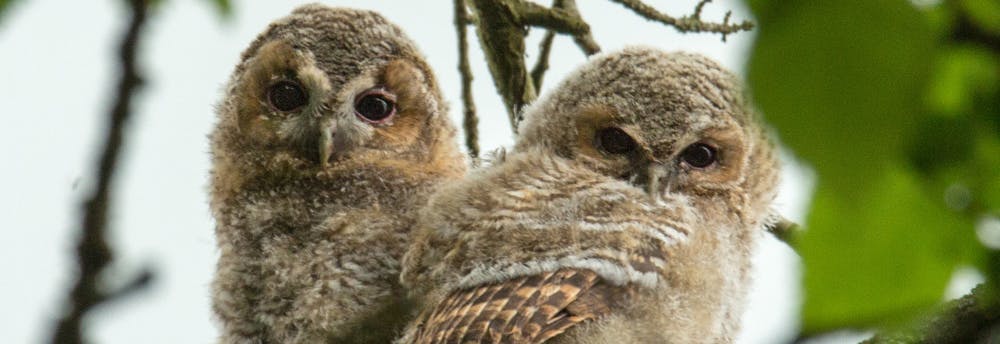
Facts and fiction about Britain's most common owl, our beloved Tawny.
We're slightly obsessed with the wonderful Tawny Owl (Strix aluco) as we are blessed with at least 4 pairs of them on our farm. So obsessed, that I've been doing lot of research and learnt many new facts about these beautiful birds. Many of our guests comment on all the incredible nocturnal sounds they hear whilst staying in The Cottage Beyond, so we thought we'd share our newfound knowledge. Keep reading and you may learn something new too!
You've got to love an owl! When you have been raised on a diet of modern children's literature you can't fail to be in awe of them. They are our friends; they are wise and they are our teachers.
These notices had been written by Christopher Robin, who was the only one in the forest who could spell; for Owl, wise though he was in many ways, able to read and write and spell his own name WOL, yet somehow went all to pieces over delicate words like MEASLES and BUTTERED TOAST" A.A.Milne
Sadly, we can find no evidence that they are wise or intelligent, but we have unearthed the following.
Interesting Tawny Facts
1. They are the most common bird of prey in Britain. Described as Pigeon size with a large round head and noticeably tubby body but with surprisingly long legs.
2. There are no Tawny Owls in Ireland, or on any island around our shores, as they don't fly across water or large open areas. They love deciduous or mixed woodlands, tree-dotted farmland, parks, large gardens and churchyards; however, they are also often spotted in built-up areas, and even inner cities.
3. No one Tawny says "Tu-whit Tu-who" - such a call is the combination of a female's contact call "Ke-wick" with the male answering "hoo hoo hoo". So, the next time you hear the familiar "Tu-whit Tu-who" you'll know you are listening into a conversation.
3. In Europe, Tawnys are blamed for more injuries to humans than any other bird! They are extremely protective of their young, and should something pose a threat, the adults will strike the faces of their invaders with their strong, sharp claws. Anyone wanting to get close is advised to wear a crash helmet!
4. They swallow their prey whole, small mammals, rodents, frogs, fish, insects and worms, and then regurgitate the inedible parts such as teeth, bones, feathers and fur as pellets, with the sharp bits enveloped in the fur to prevent damage on regurgitation. They locate their prey mainly by sound, sitting silently upon a branch. Their hidden ears, slightly out of alignment with each other, gives them incredible directional hearing allowing for pinpoint accuracy. They don't like rain, as the sound of the raindrops obliterates the sounds of the movement of their prey
5. The eyes of the Tawny Owl are quite large compared to the rest of their heads, with almost no room for eye muscles. Their incredible head rotation of 270 degrees makes up for their inability to move their eyes.
6. Tawny Owls are monogamous, pairing for life and only taking on another partner should their spouse die. Apparently, they do not grieve (not sure how they measured that)! If their spouse dies, they are quickly replaced, taking between 2 days and a few months to do so.
7. They are exceedingly territorial and never venture far. Once a pair secures a territory, they defend and retain it for life.
8. They are not great nest builders, Tawnys prefer to find a disguarded magpie nest or hole in a tree in which to lay their eggs. Laying between 2 to 6 eggs, incubation begins as soon as the first egg is laid so that the owlets hatch successively to maximise the chance of some surviving. Take note - Tawny owlets are good climbers, so if you find one on the ground, leave it be, it should climb back up into its nest.
9. As parents, they get a gold star for the first 6 months. They patiently incubate the eggs, rear the young and feed them continuously for many months after fledging BUT then they suddenly stop. The young owls are deemed independent (or the adults have just had enough!), the feeding stops, their cries are ignored, and they are pushed away.
10. Which brings us to now, late summer and throughout the autumn, the hooting season! The young urgently need to find food but no other owl, even if it is your parent, will let you feed from their territory. To make sure everyone knows who owns which territory they hoot, and hooting is contagious; one hoot and the whole neighbourhood hoots! When hooting doesn't work, they'll get physical. It's brutal out there, the poor owletts need to find their own territory, find someone in need of a new mate or die. Only about 1 in 3 make it to adulthood.
Finally, I think they're cute - 'Tu-whit Tu-who' - don't you?






